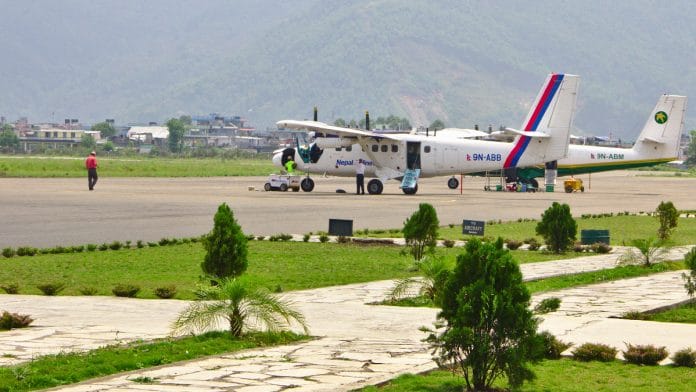New Delhi: Nearly 50 years after it was envisioned in 1975, Nepal’s Pokhara International Airport opened to much fanfare on 1 January, 2023.
The first flight to land on its runway carried Prime Minister Pushpa Kamal Dahal (Prachanda) and his entourage, while the administration declared a public holiday in Pokhara for residents to soak in the occasion.
The bubble, however, burst soon, leaving the airport with no international flights and the Nepal government hundreds of millions of dollars in debt to China.
The expensive airport — constructed with a $215.96 million soft loan from the Export-Import Bank of China — saw its first international flight land only on 21 June, a full six months after its inauguration.
However, there was a catch. The flight, a Sichuan Airlines aircraft from Chengdu, was chartered by Beijing, and carried Chinese athletes and officials who arrived for a “good-will boat tour”, as reported by The New York Times.
According to media reports, the airport now has to shell out $3.2 million annually as interest, as well as foot the bill for other operating costs.
A day before its inauguration, the Chinese embassy declared the airport a “flagship project of China-Nepal BRI (Belt and Road Initiative) cooperation”.
However, as reported by ThePrint earlier, Nepal’s ambassador to India Shankar P. Sharma had said that all developmental projects jointly undertaken by Beijing and Kathmandu had been through bilateral agreements and not under the BRI.
Shivam Shekhawat, a junior fellow at the Observer Research Foundation, told ThePrint that in June 2023, when Prachanda visited India, the issue of more air routes between India and Nepal was brought up. While India promised to look into it, the association with the BRI made it complicated for India.
“As New Delhi isn’t a part of the BRI, the airport’s association with the initiative in any way will derail any prospects of India approving new air routes,” Shekhawat had said.
The BRI, described by China as the “project of the century,” involves more than 150 countries, many of which are emerging economies. It aims to create new trade routes connecting China to the world through extensive infrastructure projects, including the construction of ports, roads, railways, and airports and other infrastructure.
Pokhara – a project troubled from the beginning
The airport’s construction was stalled for decades due to political instability, budgetary concerns and red tape until China stepped in, the NYT reported.
In 2011, Nepal’s then finance minister Barsha Man Pun signed a memorandum of understanding with China CAMC Engineering, a company affiliated with China National Machinery Industry Corporation (SINOMACH) for the construction of the airport, reported The Kathmandu Post.
This was before the bidding process had started for the project. Finally, in February 2012, the Civil Aviation Authority of Nepal (CAAN) invited bids for constructing the airport. However, there was a caveat. Since the project was funded by the Exim Bank of China, only approved bidders from a list were allowed according to the report.
The Kathmandu Post reported that of the 22 firms that purchased bid documents, only nine submitted bids. Of those nine, six bids disappeared as they were not on the list provided by China’s Exim Bank.
Only three bidders remained, and all of them were Chinese firms. CAMC Engineering quoted a price of $305 million, Sinohydro Corporation quoted $337.82 million and China International Water and Electric Corporation quoted $349.28 million.
The lowest bid, that of CAMC Engineering, was 85 per cent higher than the government’s estimate of around $166 million. It did not end there. After the price was eventually agreed at $215.96 million, the Exim Bank added a new clause — the establishment of a joint escrow account between CAAN and the bank where income from all of Nepal’s airports would be deposited, The Kathmandu Post reported.
Eventually, it was agreed that only the revenue generated from Pokhara would be deposited in the escrow account, as reported by The Kathmandu Post.
However, construction could only begin in April 2016 after then prime minister K.P. Sharma Oli travelled to Beijing and signed the soft loan deal. The airport was inaugurated seven years later.
China’s interest in infrastructure projects abroad
Alka Acharya, professor of Chinese studies at Jawaharlal Nehru University and honorary director of the Institute of Chinese Studies, said that China, like other economic powers in the past, “has also looked at investment in infrastructure as a means to expand its influence and acquire strategic leverage”.
Gunjan Singh, assistant professor at O.P. Jindal Global University, told ThePrint: “Infrastructure is an attractive proposition for China to invest in as it has exhausted its domestic market and so needs to build abroad due to its own internal over capacity. But this comes at a cost for local countries.”
This is not the first time China has funded a large investment project in South Asia. It aggressively loaned money to Sri Lanka, which defaulted on its external debt obligations during the economic crisis in April 2022.
“Sri Lanka was a wake-up call. Leaders build to win elections and not necessarily plan for the long term. China is willing to invest because it will profit from it,” Singh told ThePrint.
But countries face another challenge — Beijing or its institutions push for Chinese firms to be given contracts for construction, and Chinese workers are brought in to finish the projects.
This, coupled with the general perception that construction by China is “low quality”, creates a situation where countries are apprehensive about the final product, Singh said.
“However, there are reasons countries look to China for financing… International financial institutions may not give loans for large infrastructure projects, which China has no issues in doing,” Singh added.
(Edited by Tikli Basu)
Also read: BJP’s overconfidence in UP is backfiring. Tiffs with coalition partners make matters worse






